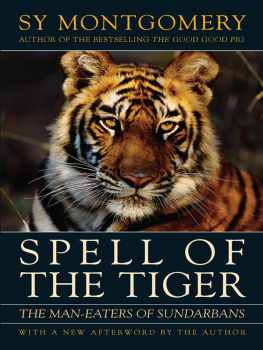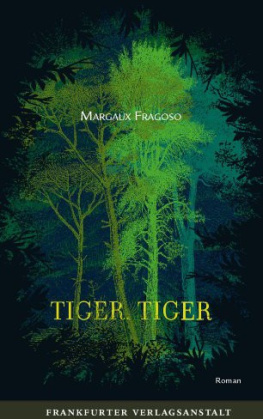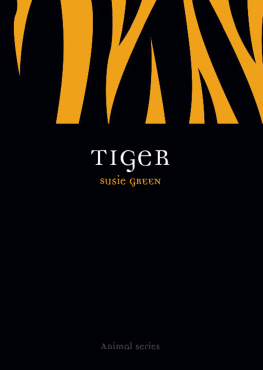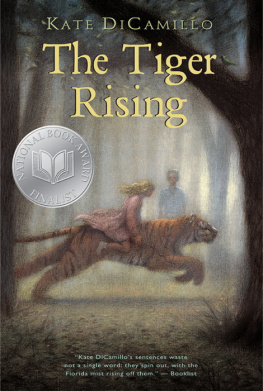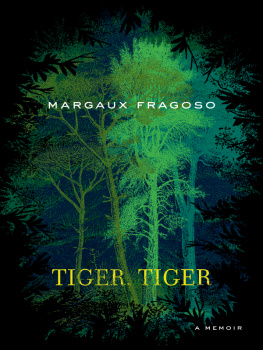PRAISE FOR Spell of the Tiger
Fascinating... moving.The New York Times
Spine-chilling. The Washington Post
Sy Montgomery puts the fear of God into you with her tales of the great mangrove swamp of Sundarbans. Los Angeles Times
In a spiritual comprehension, people of the Sundarbans know that without the tiger, their human world is incomplete.
Time
A tantalizing glimpse of the shifting boundary between nature and myth.Kirkus Reviews
Sy Montgomerys Spell of the Tiger should be distributed free of charge to pharmaceutical outlets in China, Hong Kong, the Chinatowns of New York and San Francisco, and wherever tiger parts are sold... Her prose is so succinct, her descriptions so moving, that we journey with her through the Sundarbans into our own conscience. New Asia Review
Not since Jim Corbett wrote Man-Eaters of Kumaon has there been a better book on tigers. Never has there been a better book on the coastal forests of India and Bangladesh and the people who inhabit them. Spell of the Tiger is a work of genius, filled with beauty and suspense.
Elizabeth Marshall Thomas,
author of The Tribe of Tiger
Spell of the Tiger is a splendid, transcendental book, distilled like brandy. Lovers of nature should love it.
Edward Hoagland, author of Red Wolves and
Black Bears and The Courage of Turtles
OTHER BOOKS BY SY MONTGOMERY
Walking with the Great Apes:
Jane Goodall, Dian Fossey, Birute Galdikas
The Curious Naturalist: Natures Everyday Mysteries
The Wild Out Your Window
Journey of the Pink Dolphins: An Amazon Quest
Search for the Golden Moon Bear:
Science and Adventure in Pursuit of a New Species
The Good Good Pig: The Extraordinary
Life of Christopher Hogwood
FOR CHILDREN
The Snake Scientist
The Man-Eaters of Sundarbans
Encantado: Pink Dolphin of the Amazon
Search for the Golden Moon Bear:
Science and Adventure in the Asian Tropics
The Tarantula Scientist
Quest for the Tree Kangaroo
SPELL OF
THE TIGER
THE MAN-EATERS OF SUNDARBANS
SY MONTGOMERY
CHELSEA GREEN PUBLISHING
WHITE RIVER JUNCTION, VERMONT
Copyright 1995, 2008 by Sy Montgomery
Foreword copyright 2008 by Sy Montgomery
All rights reserved, including the right of reproduction in whole or in part in any form.
To request permission to reproduce from this book, contact Chelsea Green Publishing.
Originally published by Houghton Mifflin Company, 1995.
This edition published by Chelsea Green Publishing, 2008.
Printed in the United States of America.
10 9 8 7 6 5 4 3 2 1 08 09 10 11 12
Our Commitment to Green Publishing
Chelsea Green sees publishing as a tool for cultural change and ecological stewardship. We strive to align our book manufacturing practices with our editorial mission and to reduce the impact of our business enterprise in the environment. We print our books and catalogs on chlorine-free recycled paper, using soy-based inks whenever possible. This book may cost slightly more because we use recycled paper, and we hope youll agree that its worth it. Chelsea Green is a member of the Green Press Initiative (www.greenpressinitiative.org), a nonprofit coalition of publishers, manufacturers, and authors working to protect the worlds endangered forests and conserve natural resources. Spell of the Tiger was printed on 55-lb. Natures Natural, an FSC-certified, 30-percent postconsumer-waste recycled paper supplied by Thomson-Shore.
Chelsea Green edition
The previous edition included the following Library of Congress
Cataloging-in-Publication Data
Montgomery, Sy.
Spell of the tiger: the man-eaters of Sundarbans / Sy Montgomery.
p. cm.
Includes bibliographical references.
eBook ISBN: 978-1-60358-146-2
1. Tigers Sundarbans (Bangladesh and India)Folklore. 2. Tigers
Sundarbans (Bangladesh and India) 3.FolkloreSundarbans
(Bangladesh and India) I. Title.
GR 307. s86M66 1995
398.369974428dc20 94-23190 CIP
Book design by Peter Holm, Sterling Hill Productions
Chelsea Green Publishing Company
Post Office Box 428
White River Junction, VT 05001
(802) 295-6300
www.chelseagreen.com
As always,
For Dr. A. B. Millmoss
CONTENTS
W herever it is found, the tiger evokes a reverence, dread, and wonder accorded no other animal.
In Sumatra holy men commune with tigers in order to speak with dead heroes. In South Thailand and peninsular Malaysia, Negrito pygmies tell us the tiger is the avenger of the Supreme Being, Karei, punishing those who break tribal taboos. The Mendriq believe the tiger is the son of the thunder god and the goddess who dwells in the center of the earthto them the tiger is the connection between the thunderstorm and the underworld. In India gods ride the tigers back: Jolishmatic, the goddess of miraculous drugs; Aurkah, commander of the thirty-three-year cycle; Shukra, priest of demons; and the avenging Durga, wife of the great god Shiva. All choose the tiger as their vahana, or vehicle. In Hindu mythology a vahana does not carry a god in the ordinary sense that a car carries a passenger. Rather, as religious historian Wendy Doniger points out, the mount carries the god in the way that a breeze carries a perfume. The tiger is permeated, saturated with the gods force and power, imbued with the essence of the god itself.
Everywhere it roams, the tiger is credited with powers beyond those expected of any worldly animal.
Nowhere are those powers more fearful than in Sundarbans, the largest tidal delta in the world. Here, unlike any other place on earth, the tiger regularly hunts people. Hundreds die each year in the tigers jaws.
Yet there is no eradication campaign directed against the tigers of Sundarbans, as there have been against far less lethal predators in the West. Here the tiger is feared but not hated; here it is worshiped but not loved. For here the tiger is a sacred creature who rules an enchanted land.
Spell of the Tiger is an invitation to visit this land. In Eastern legends vision quests into unknown territories were often made on the back of a tiger. In this book the tiger will carry the reader on a spiritual journey to a land where nature and God are one. But it is a journey we may soon be unable to make. Due to global climate change, Sundarbans is being rapidly eaten away by a rising sea. And soon there may be no more tigers to carry us there.
It is my belief that the end of the tiger is in sight, Peter Jackson, chairman of the Cat Specialist Group of the World Conservation UnionIUCN told me when I began to research the first edition of this book in 1992. That year an estimated 400 tigers were killed in India, reducing the worlds population of tigers to fewer than 7,000.
The tigers future looked so bleak that just a year later, some people had already given up on it. I mourn the passing of a beautiful, majestic beast, pronounced Adam Holland, the general editor of Asiaweek, in a 1993 cover story in that magazine, but the tiger in the wild stands as much chance of survival as an antique building in Hong Kong. The next year, Time put the tiger on its cover with the headline Doomed.
At the turn of the 20th century, tigers occupied vast areas of Asia, from the Russian Far East to Java. Turkeys Mount Ararat, near the border with Iran, was said to be infested with them up to the snow line. Tigers hunted wapiti in the dwarf oak forests west of Mongolias Great Gobi; gigantic, long-furred tigers stalked mountain sheep through Russian blizzards; tigers padded through the steaming rain forests of Bali. An estimated 40,000 Royal Bengal tigers inhabited Indias jungles and grasslandsso many that it has been said that in the early 1900s, two maharajas could shoot 2,000 tigers between them in their spare time.

